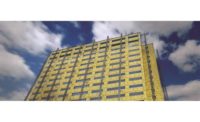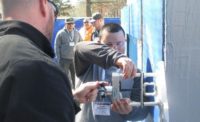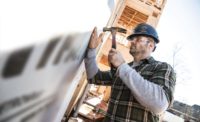There are many types of air barrier products to consider when designing your exterior wall cladding system. Knowing the desired performance of your wall system and construction methods are key, and narrowing down your selection to a few products depends on various factors.
The two primary categories of air barriers are sheet air barriers and fluid-applied air barriers. Both types are generally suitable underneath most cladding configurations; however, substrate conditions and other factors may determine that one type of air barrier is more appropriate than the other. Developing a set of design and installation parameters such as the following will help you make a decision when selecting an air barrier.
Design Parameters
The first set of parameters to consider has to do with the overall design of the exterior wall system:
- Is a vapor barrier or vapor permeable membrane needed?
- What type of wall configurations, rough openings, fenestration system and expansion joints are part of the exterior walls?
- Will the air barrier be exposed through cladding joints or at transitions?
- What material will be directly installed over the air barrier? Cladding, drainage plane, continuous insulation?
- What materials will the air barrier need to transition to or come in contact with?
- Is exposure to high temperature conditions a concern for the membrane?
Installation Parameters
The second set of parameters has to do with the construction and installation of the air barrier and cladding system:
- What will the installation method of the air barrier system be?
- How much time is allowed for the installation of the air barrier, and how long will it be exposed to the elements?
- Are there any weather restrictions for the application of the air barrier system?
- How soon will the cladding system be installed over the air barrier?
- What is the skill level of the applicator, and what type of products have they successfully installed in the past?
Generally, fluid-applied air barrier systems are going to be more ideal for fast-paced construction and complicated cladding and anchoring configurations. Irregular fenestration or joint patterns are design aspects that may be more suited for fluid-applied systems as well. Sheet membranes are best used for conventional building geometries with regular and repetitive detailing, as well as a phased construction. Varying conditions that require revising the sequencing of sheet membranes will introduce risk to the project.
Sheet Air Barriers
When considering a sheet air barrier underneath your cladding system, evaluate what type of fasteners will be used to attach the membrane and the cladding system, and what the detailing may be as they pass through the membrane. Fully adhered air barrier systems are also available. Keep in mind that fewer penetrations through the waterproofing will reduce the risk of water intrusion to the building. Lapped and sealed seams are important to providing continuity in the air barrier system.
Quality control regarding the installation and sequencing of the sheets is especially critical to ensure that reverse laps and water intrusion opportunities are avoided. Make sure your cladding system does not interface with the sheet membrane in a way that would compromise its performance. An example of this would be continuous horizontal strut supports for the cladding that are directly mounted over the air barrier, resulting in water accumulation against the membrane at each interface.
The most basic sheet air barrier is an asphalt-impregnated kraft paper referred to as Grade “D” paper. Generally, conventional building paper does not hold up well behind cladding systems that allow water to penetrate the surface, or if there are continual wetting cycles that the wall system and air barrier will be exposed to throughout the year.
Synthetic sheet air barriers range from spun bonded high density polyethylene (HDPE) fibers, polypropylene fabrics, polyolefin, and polymer technologies. These materials typically have improved sealing capabilities around fasteners and cladding anchors compared to conventional building paper. Make sure the sheet air barrier that is being considered has passed the “nail sealability” requirements of a modified test based on the requirements of ASTM D1970.
Fluid-applied Air Barriers
A fluid-applied air barrier provides a monolithic and seamless membrane behind the cladding system, eliminating seams and supposed weak points that are more frequent in sheet air barrier systems. Fluid-applied membranes can be spray-applied or rolled onto the wall, and are much more adept at waterproofing complex wall conditions and penetrations compared to sheet air barriers. Another advantage of a fluid-applied air barrier system is the ease of detailing at fasteners, wall openings, and repair locations. Typically, the same fluid-applied material or similar formula can be used to waterproof these interfaces.
There are more fluid-applied air barrier options available for open joint cladding designs and high temperature conditions. The chemistry of these membrane products are engineered to better take on these conditions compared to sheet air barriers. There are generally three main types of fluid-applied air barriers that are currently being used in construction today: silicone, silyl terminated polyether (STPE), and acrylic. Silicone air barriers have high temperature resistance and have the capability to withstand ultra violet (UV) exposure. STPE and hybrid formulas are generally acceptable over moist substrates and can take on some UV exposure. Fluid-applied acrylics generally need to be concealed underneath cladding and are usually not suitable over moist conditions.
Based on the above information and parameters, you should be able to narrow down your selection to one of the air barrier categories, and proceed to evaluating different product and manufacturer options with your team in order to compare performance, warranty, and installation criteria that is important to the project.
Quality Control Measures
The selection of the right air barrier system behind the cladding is only part of the work in achieving a good exterior wall system. The remainder of the work involves the quality control of the air barrier installation in the field, as well as the cladding system. Quality control measures for each type of membrane varies, and a significant amount of responsibility is placed on the applicator when it comes to the installation. The skill level of the applicator is critical to this process, as well as their experience with the product that is being installed.
Once the sequencing is established for the installation of a sheet membrane system, there should not be any deviations in the field that alter the lap sequences, unless they are specifically detailed by the Architect or Exterior Enclosure Consultant. For fluid-applied air barrier systems, consistency in the mil thickness of the membrane and proper coverage at detail interfaces are the things to look for. It is important to understand that even if the right air barrier is selected, the alteration of details in the field may result in water intrusion or failed performance if proper quality control measures are not taken.
In addition to the two categories of air barrier systems, new advancements in the prefabrication of construction materials include exterior wall boards with an integral membrane that is pre-applied during the manufacturing process. Wall board panels are installed with an air barrier product intact, and the seams are treated in the field to provide a continuous air barrier system. Advancements such as these rely less on the applicator’s experience with air barriers; however, they take quality control to the next step with the elimination of certain field installation variables. On the other hand, these products may limit our approach during the air barrier selection process, since our options will be based on the company or companies that have formed partnerships with one another to come up with these integral wall board and air barrier systems.






